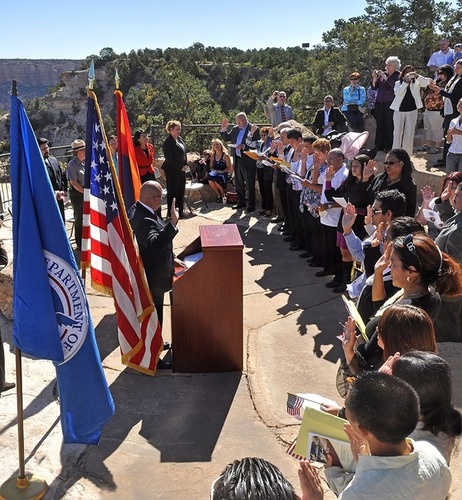
(function(d, s, id) { var js, fjs = d.getElementsByTagName(s)[0]; if (d.getElementById(id)) return; js = d.createElement(s); js.id = id; js.src = “https://connect.facebook.net/en_US/sdk.js#xfbml=1&version=v3.0”; fjs.parentNode.insertBefore(js, fjs); }(document, ‘script’, ‘facebook-jssdk’)); –>
–>
January 22, 2024
One Virginia household had much to be thankful for and celebrate this past holiday season. After 14 long months dealing with U.S. immigration authorities, the foreign-born spouse of a U.S. service member was approved for her “green card” and finally allowed legal entry into the U.S. to reunite with her husband, her case favorably adjudicated.
‘); googletag.cmd.push(function () { googletag.display(‘div-gpt-ad-1609268089992-0’); }); document.write(”); googletag.cmd.push(function() { googletag.pubads().addEventListener(‘slotRenderEnded’, function(event) { if (event.slot.getSlotElementId() == “div-hre-Americanthinker—New-3028”) { googletag.display(“div-hre-Americanthinker—New-3028”); } }); }); }
This instance of legal immigration stands in stark opposition to what the Biden administration is allowing to occur at our nation’s southern border. As many as 10 million people have been reported illegally entering the U.S. since President Joe Biden took office in January 2021, with nearly 1.6 million known “gotaways” and hundreds of thousands of inadmissible aliens now granted parole into the country every month. In fiscal 2023 alone, there were more than 3.2 million illegal border crossings nationwide, a total that approximates the annual number of U.S. births. December alone saw more than 300,000 migrant border “encounters — an average of 10,000 per day, the highest monthly total ever recorded. Most enter believing U.S. borders are “open” and remain with scant fear of deportation.
We’re told that those entering illegally are “vetted” before being released into communities. But they are, in fact, released after minimal “processing.” This means taking photos and fingerprints, entering unverifiable names and birth dates, running this data through U.S. law enforcement and immigration databases, and creating an immigration file if none exists. It should further entail ensuring that each unknown migrant isn’t a known terrorist, and doesn’t have a criminal record, contagious disease, or prior immigration violation, but most often does not simply due to the sheer numbers overwhelming border authorities. For release into the country, all that many get is a token “notice to appear” at an immigration court hearing — often years in the future — to argue why they shouldn’t be deported for being here illegally.
What then explains legal immigration being so bureaucratically stringent for a foreign national to enter the country? This is exceptionally true for a person — with a sponsor no less — applying legally with verifiable identity, documented medical records, certifiable education, provable means of support, and justifiable reason for entry.
‘); googletag.cmd.push(function () { googletag.display(‘div-gpt-ad-1609270365559-0’); }); document.write(”); googletag.cmd.push(function() { googletag.pubads().addEventListener(‘slotRenderEnded’, function(event) { if (event.slot.getSlotElementId() == “div-hre-Americanthinker—New-3035”) { googletag.display(“div-hre-Americanthinker—New-3035”); } }); }); }
No case underscores this legal-versus-illegal chasm like what happened to the service member and his foreign-born spouse at the end of his overseas tour.
 Our family friends’ son enlisted and then assigned to Europe for a multi-year tour of duty. While stationed there he met and married a European woman in April of 2022. In early September 2022, with his tour of duty complete, he — with his new wife — were scheduled for transfer back stateside for a new assignment. He returned to the U.S. on schedule that September while his wife was denied entry and remained in Europe. Only in late November of 2023 was his spouse finally granted legal entry into the United States.
Our family friends’ son enlisted and then assigned to Europe for a multi-year tour of duty. While stationed there he met and married a European woman in April of 2022. In early September 2022, with his tour of duty complete, he — with his new wife — were scheduled for transfer back stateside for a new assignment. He returned to the U.S. on schedule that September while his wife was denied entry and remained in Europe. Only in late November of 2023 was his spouse finally granted legal entry into the United States.
Over those 14 months, the spouse endured a thorough vetting process — all completed outside the U.S. — unlike any those entering illegally across the southern border undergo. The couple had to assemble documentation, pay fees, submit to a medical examination, and be interviewed at an overseas consulate.
The sponsor — her husband — had to be a U.S. citizen or green card holder (permanent resident); earn at least 100% of poverty guidelines for their household; accept financial responsibility for his spouse, and not have previously committed certain crimes.
The wife was required to prove her identity, nationality, and current U.S. immigration status (if any); and also not have previously committed certain crimes or immigration violations.
Together they had to demonstrate marriage authenticity; prove termination of previous marriages, and submit supporting documentation (including military service records).
‘); googletag.cmd.push(function () { googletag.display(‘div-gpt-ad-1609268078422-0’); }); document.write(”); googletag.cmd.push(function() { googletag.pubads().addEventListener(‘slotRenderEnded’, function(event) { if (event.slot.getSlotElementId() == “div-hre-Americanthinker—New-3027”) { googletag.display(“div-hre-Americanthinker—New-3027”); } }); }); } if (publir_show_ads) { document.write(“
Then came the wait for adjudication. When movement on her case came to an apparent standstill with nothing heard, the husband’s family further sought assistance from a member of Congress and retained counsel at their expense to file legal action with the U.S. government with the intent to speed up and complete the process for the wife’s immigration.
The toll on the newlyweds from their prolonged 14-month separation was understandably rough, but they are thankful knowing it could have been longer. One on-line guide to navigate the process states one “can expect to wait 17 months, not including possible delays.”
Instead of complying with legal immigration protocol, one wonders if the better solution to the couple’s dilemma would have been to fly her to Mexico, march to the southern border, and walk across along with the millions from around the globe entering the U.S nearly at will with little fear of deportation.
More seriously, despite disputable Biden administration officials’ assurances, it is clear our laws and processes for legal immigration do not concern this administration nor are enforced at our porous southern border. The frustrating irony is those who comply with the law, complete each step of the process, and then must wait for adjudication take a distant second place to those who willfully disregard our laws but enter our nation through that border.
Image: Grand Canyon National Park
<!–
–>
<!– if(page_width_onload <= 479) { document.write("
“); googletag.cmd.push(function() { googletag.display(‘div-gpt-ad-1345489840937-4’); }); } –> If you experience technical problems, please write to [email protected]
FOLLOW US ON
<!–
–>
<!– _qoptions={ qacct:”p-9bKF-NgTuSFM6″ }; ![]() –> <!—-> <!– var addthis_share = { email_template: “new_template” } –>
–> <!—-> <!– var addthis_share = { email_template: “new_template” } –>





